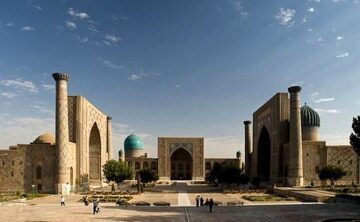 |
The Registan ensemble at the heart of Samarkand, restored to its original splendor, ranks first among the greatest of all magnificent works of the Islamic world. It’s meaning, sandy place, after a stream that washed sand over the earth. The Registan square consist of three monumental madrassahs: Ulugbek Madrassah (1417—1420), Sher Dor Madrassah (1619—1636) and Tilla Kari Madrassah (1646—1660)
Ulugbek Madrassah. Tamerlane’s grandson Ulugbek’s legacy is educational. Legend claims the ruler himself lectured here on astronomy, his greatest passion, reflected in the panoply of azure-blue stars on 35- meter portal. A Kufic (an early angular form of the Arabic alphabet) inscription reads: “This magnificent façade is of such a height it is twice the heavens and of such weight that the spine of the earth is about to crumble”. A yellow-brown background, the colour of the earth, its size is more balanced by the sheer elegance of its design and ceramic tile coating. Mosaic and majolica panels shine with floral motifs and Kufic calligraphy. Two 33 – meter minarets flanking the façade, terminate in honeycomb decoration.
Sher Dor Madrassah. The Registan’s second Madrassah, built by order of Uzbek Governor of Samarkand Shaybanid Yalangtushbiy Bakhodur between 1619 and 1636. His architects strove to match the first in scale and nobility. Façade length is identical, 51 meters from minaret to minaret. Every inch seems covered with richly colored floral and epigraph patterns. Above portal arch, in hot pursuit of two startled white does, through spiraling shoots and flowers, run the lions that give the Madrassah its name, Sher Dor – “lion –bearing”. The striped beasts resemble tigers and from their backs rise beam-fringed suns with human faces. The powerful lion-tiger is Amir Yalangtushbiy himself, swallowing his neighbors as sun radiates his glory; or rather the animal-sun shows the tenacity of pre-Islamic Zoroastrian solar symbolism. Legend claims the architect responsible died for his heresy, yet other 17th century madrassah similarly adorned. The choice of colors, blue, white, yellow and green reflects Bukhara influence.
Tilla Kari Madrassah. To enclose the square in pleasing harmony, Amir Yalangtushbiy ordered his architects to stretch the facades of the third Madrassah to 75 meters, built between 1646 and 1660. Smaller corner turrets are preferred to minarets, but the mosaic feast is just as lavish – sprightly solar symbols and interlacing floral motifs in similar colours to the Sher Dor. Its magnificent interior is swathed in kundal style gold leaf – hence the title Tillya Kari, “gilded”. Tillya Kari declares its religious purpose with two storeys of hujra, ventilated by panjara, carved plaster windows. The domed prayer galleries display exhibitions of terracotta and mosque decoration.
The Registan Ensemble was rightfully included in the UNESCO World Heritage List in 2001.
Useful links:
Other Historical sights
Samarkand
Tours round Samarkand
One day tour excursion to Samarkand





